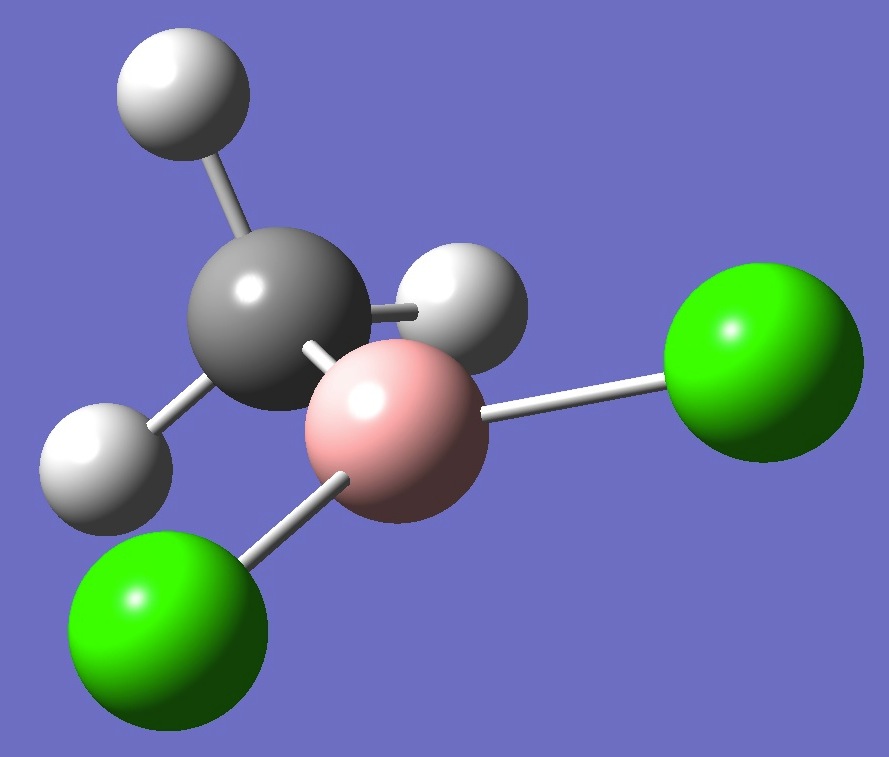|
|
|
|
|
|
|
|
|
|
|
|
|
|
|
|
|
|
|
|
|
CH3BCl2
|
|

|
|
|
|
|
|
|
|
|
|
|
|
|
|
|
|
|
|
|
|
|
|
|
|
|
|
|
|
|
|
|
|
|
|
|
Boron and Chlorine |
|
|
|
Nuclear
Quadrupole Coupling Constants |
|
|
|
in Dichloromethylborane |
|
|
|
|
|
|
|
|
|
|
|
|
|
|
|
|
|
|
|
|
|
|
|
|
|
|
|
|
|
|
|
|
|
In Tables 1 and 2, the subscripts
a,b,c refer to the principal axes of the inertia tensor.
Subscripts x,y,z refer to the principal axes of the nqcc tensor. ETA = (Xxx - Xyy)/Xzz.
Ø
(degrees) is the angle between its subscripted parameters. RMS is
the root mean square difference between calculated and experimental
diagonal nqcc's (percentage of the average of the magnitudes of the
experimental nqcc's). RSD is the calibration residual standard
deviation for the B1LYP/TZV(3df,2p) model for calculation of the chlorine nqcc's. |
|
|
|
|
|
|
|
|
|
|
|
|
| |
|
|
|
|
|
|
|
|
Table 1. Boron
nqcc's in CH3B35Cl2 (MHz). Calculation was made on ro structure [1].
|
|
| |
|
|
|
|
|
|
|
|
|
|
|
Calc. |
|
Expt. |
|
| |
|
|
|
|
|
|
|
|
11B |
Xaa |
- |
0.549 |
|
|
|
|
|
Xbb |
- |
2.876 |
|
|
|
|
|
Xcc |
|
3.426 |
|
|
|
|
|
|Xbc| |
|
0.007 |
|
|
|
|
|
|
|
|
|
|
|
|
|
|
|
|
|
|
|
|
|
|
|
|
|
|
|
|
|
|
|
|
|
|
| |
|
|
|
|
|
|
|
|
Table 2.
35Cl nqcc's in CH311B35Cl2
(MHz). Calculation was made on ro structure [1]. |
|
| |
|
|
|
|
|
|
|
|
|
|
|
Calc.
|
|
Expt. [1] |
|
| |
|
|
|
|
|
|
|
|
35Cl |
Xaa |
- |
20.85 |
- |
21.14 * |
|
|
|
Xbb |
|
14.56 |
|
12.59 * |
|
|
|
Xcc |
|
6.29 |
|
8.55(51) |
|
|
|
Xab |
±
|
30.93 |
|
|
|
|
|
Xac |
|
± 0.04
|
|
|
|
|
|
Xbc |
|
0.68
|
|
|
|
|
|
|
|
|
|
|
|
|
|
RMS
|
|
1.74 (12. %)
|
|
|
|
|
|
RSD
|
|
0.49 (1.1 %)
|
|
|
|
|
|
|
|
|
|
|
|
|
|
Xxx |
|
32.50 |
|
|
|
|
|
Xyy |
|
6.28 |
|
|
|
|
|
Xzz |
- |
38.79 |
|
|
|
|
|
ETA |
- |
0.676 |
|
|
|
|
|
Øz,BCl |
|
1.2
|
|
|
|
|
|
|
|
|
|
|
|
|
|
|
|
|
|
|
|
|
|
|
|
|
* Calculated here from the Xcc and Xaa - Xbb = -33.73(36)
MHz. |
|
|
|
|
|
|
|
|
|
|
|
|
| |
|
|
| Table 3. Molecular structure parameters, ro [1] (Å
and degrees). |
|
|
|
|
CH |
1.103(7) |
|
CB |
1.557(5) |
|
BCl |
1.753(5) |
|
HCH |
108.5(5) |
|
BCH |
110.4 |
|
ClBCl |
117.5(5) |
|
|
|
|
|
|
|
|
|
|
|
|
|
|
|
|
|
|
|
|
|
|
|
[1] S.D.Hubbard and A.P.Cox, J.Mol.Spectrosc.
115,188(1986). |
|
|
|
|
|
|
|
|
|
|
|
|
|
|
|
|
|
|
|
|
|
|
CH3BF2 |
HBCl2 |
CH3BBr2
|
|
|
|
|
|
|
|
|
|
|
|
|
|
|
|
|
|
|
|
|
|
|
|
Table of Contents |
|
|
|
|
|
Molecules/Boron |
|
|
|
|
|
Molecules/Chlorine |
|
|
|
|
|
|
|
|
|
|
|
|
|
|
|
|
|
|
|
|
|
|
|
|
|
|
|
|
|
|
CH3BCl2.html |
|
|
|
|
|
|
Last
Modified 15 Sept 2015 |
|
|
|
|
|
|
|
|
|
|
